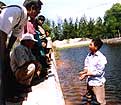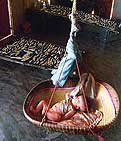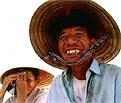|
|

Man-made ponds on the
sandy bed for shrimp rearing.

Foliage is poping up on the once barren land of
Tuong Van.

On
the way home from school.nbsp;nbsp;

Nguyen Van Loi introducing to the visitors his
tortoise-rearing pond.nbsp;

Born in the sandy land.

After the season with sand wind, the locals have
to dredge the sand out of their
garden.nbsp;

Sweet fruits of the first crop.

Le Cong
Hoi, from Linh An eco-village, still has a hard life, but his three
children are university graduates.
| I still
remember the day my colleagues and I had a mission in Trieu Phong District
of Quang Tri Province (Central Vietnam), 600 km south of Hanoi Capital.
After working and on the way back to our hotel, we had to pass a sandbank
which had been heated by the sun. It was like walking in a hot frying pan
while the wind blew the sand everywhere. Twenty years later, we revisited
this place and could not recognise it.nbsp;
Provincial Road 64, which used to wind its way among the sea
of sand in the past, is now shaded under the trees. The roads linking the
villages and communes are not bare like before but run through the gardens
of verdant fruit trees. The sandy land of Trieu Phong has been revived
with the greenness of trees prevailing everywhere, giving a feeling of
freshness and peacefulness.
Following the suggestion of Bui
Quang Sinh, Chairman of Quang Tri Farmers' Association, we visited the
house of Nguyen Van Loi and his wife, Nguyen Thi Chung, near Road 64 in
Vinh Hoa Village, Trieu Van Commune, who had overcome many difficulties to
prosper in this area.
nbsp;With a simple and honest
voice of a person living in a coastal area, he told us that during the war
and even in the 1980's, the enemy's bombs as well as sunshine and rains
had turned his native place into a poor and miserable area. The villagers
wanted to move to other places to earn their living and avoid the plight
caused by sunshine, wind and sand. But for him, he could not leave his
beloved native home. He thought that wherever he went he would struggle to
survive with his own hands. When the State advocated turning his area into
an ecological village he and his wife responded immediately. Although
living in a shelter made from four corrugated iron sheets he still
nurtured a big ambition to become well off. At the initial period he zoned
off an area and borrowed money to grow groundnuts and potatoes. Then he
grew thousands of seedlings. The life of his family gradually improved and
he even accumulated a small sum of money. As his savings increased, Loi
shifted to cultivating and raisingnbsp; crops and animals of high value.
Later he started to provide services and raise tortoises for export. From
empty hands, he became a small master in the area and had an annual income
of nearly VND 150 million, a no small sum for a Trieu Van villager.
Not far from Loi's house is the
home of Nguyen Van Minh who is considered a symbol of the diligence and
assiduousness of Quang Tri people. Minh said that the area had severe
natural conditions. The villagers used to wear a raincoat, even in sunny
days to avoid the impact of the sand and wind. They could not dry fish,
shrimp, sweet potatoes or cassavas because of the sand. Their lifestyle
was closely linked with the sand, from birth to death. Only when the
ecological village was established he had a new life and knew that people
in other places could live with the sand. Minh, his wife and children
persistently followed an economic model of gardening-fishpond-animal
husbandry under the guidance of the agricultural extension cadres. He
built a pond in his garden to raise fish and irrigate the trees. His
family's efforts have paid off. Now his garden is full of fruit trees and
crops, such as mango, longan and gourd, with the same output as in a
fertile plain area, which earns him millions of Vietnam dong. He said that
the people's life in this area is also much more comfortable than before.
Each year he earns nearly VND 30 million from farming. What makes him feel
most satisfied is the fact that he has a stable life on a sandy area and
all of his children are well off. nbsp;
Now the villagers feel secure
in co-existing with the sand. Apart from farming and animal husbandry,
they also undertake aqua-culture. They contribute money to build ponds and
lakes for shrimp raising, which yields 2-3 tonnes of shrimp per ha each
crop and brings in an income of VND 100-150 million.
To utilise 3,364 ha of fallow
sandy land in the whole district, Trieu Phong District authorities have no
choice but continue to encourage the people to build new ecological
villages. Along the sides of Provincial Road 64 are emerging several
ecological villages with roads, concrete houses, trees and plants and
electricity and irrigation systems, all giving a new image to the poor
rural areas.nbsp;nbsp;nbsp;
Story: Hoang
Chuong |